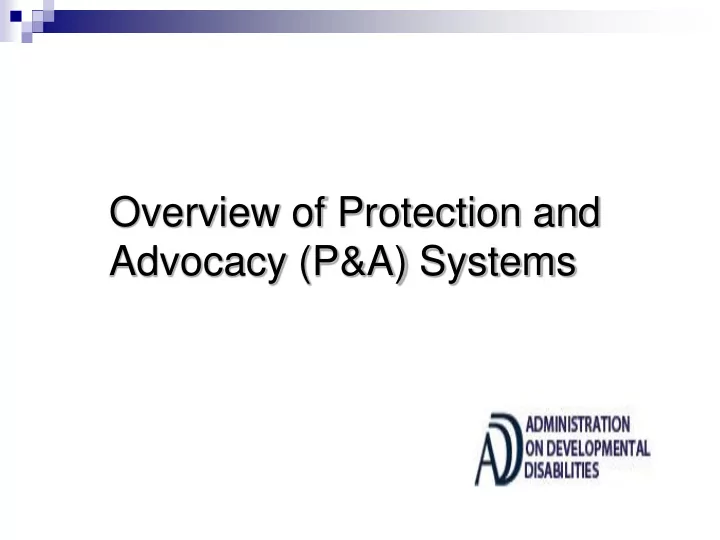

Overview of Protection and Advocacy (P&A) Systems
P&As Protection and Advocacy for Individuals with Developmental Disabilities (PADD) program Funded under Part C of the DD Act 57 P&As: In each State, Territory & District of Columbia There is a Native American Consortium P&A located in New Mexico that serves the Hopi and Navajo Nations in New Mexico, Arizona and Utah.
P&As 47 P&As are private nonprofit organizations 10 P&As are located within State government, but are free to address any civil or human rights violations
Purpose of a Protection and Advocacy System P&As help individuals with developmental disabilities secure their human and civil rights. P&As help people with developmental disabilities who have been: Neglected or abused Denied access to a service Denied control or choice of a service to which they have a right Denied the opportunity to participate in an activity
PADD is the keystone of the P&A System The Protection and Advocacy for Individuals with Developmental Disabilities began in 1975. Overtime, P&A Systems have been designated to administer other programs: PAIMI: Protection and Advocacy for Individuals with Mental Illness PAIR: Protection and Advocacy for Individual Rights PAAT: Protection and Advocacy for Assistive Technology PABSS: Protection and Advocacy for Beneficiaries of Social Security PATBI: Protection and Advocacy for Traumatic Brain Injury PAVA: Protection and Advocacy of Voting Act Client Assistance Program: Half are located with the P&A and the others are their own separate agency.
FEDERAL ADMINISTRATORS Each of the P&A programs is separately administered by the following federal agencies: PADD and PAVA programs Administration on Developmental Disabilities (ADD), located within the Administration for Children Youth and Families (ACF) at the U.S. Department of Health and Human Services (HHS). CAP and PAIR and PAAT programs Rehabilitation Services Administration (RSA), at the U.S. Department of Education (Ed). PAIMI program Substance Abuse and Mental Health Services Administration (SAMHSA),Center for Mental Health Services (CMHS), at HHS. PABSS program Social Security Administration. PATBI program Health Resources and Services Administration (HRSA) within HHS.
ADD Funding Funds distributed based on a formula Money is allotted to States based on the population, financial needs and needs for services FY 2011 Funding - 41 million
Areas of Emphasis P&As identify goals in the areas of emphasis in the DD Act based on public input Area of Emphasis includes: education, child care, quality assurance, employment , housing, transportation, recreation and health Each P&A is different and their expertise is diverse The Statement of Goals and Priorities drive the work that is done
How P&As Do Their Job Train people about their civil and human rights Educate others about the rights of individuals with developmental disabilities Investigate complaints of violations of rights Information and referral Work to resolve complaints through discussion, mediation, alternative dispute resolution and litigation Referrals to other agencies (State, Federal, local)
How P&As Do Their Job P&As will exhaust all of their remedies before going to court. Litigation is the smallest percentage of work that the P&As carry out.
Selected Highlights of P&A Requirements Authority and independence P&A Governing Board Planning responsibilities Reporting responsibilities Obligation to collaborate
Planning Responsibilities Goals and Priorities Setting The Goals and Priorities of each P&A are based on data driven strategic planning... multi-year cycle with annual updates The P&A provides an annual opportunity for the public to comment on Goals & Priorities and activities of the System, including comments by the Council and UCEDDs Goals and Priorities are submitted to ADD annually
Reporting Responsibilities Program Performance Report Data Collection (on individual advocacy, types of cases, resolution of cases, systems change and group advocacy, and information and referral) Outcomes of Goals Reporting on Collaborative Activities Program Evaluation... outcome measures and procedures for evaluating the impact of its advocacy activities
Collaboration The P&A must collaborate with other organizations including the State Council on Developmental Disabilities and the University Centers for Excellence Examples include collaborating on legal research legal advocacy training in rights issues
P&A Team Jennifer Johnson, Supervisory Program Specialist 202-690-5982 Jennifer.johnson@acf.hhs.gov Team Members Brianne Burger Program 202-618- brianne.burger@acf.hhs.gov Specialist 5525 Shawn Callaway Program 202-690- shawn.callaway@acf.hhs.gov Specialist 5781 Suad Jama Program 202-690- suad.jama@acf.hhs.gov Specialist 6059 Carla Thomas Management 202-690- carla.thomas@acf.hhs.gov Analyst 8332
Contractor National Disability Rights Network (NDRN) Purpose of Contract to improve program performance (advocacy and capacity building), statutory compliance, and program outcomes (systems change) across the P&A systems. Training and Advocacy Support Center (TASC) division of the National Disability Rights Network (NDRN) funding is sponsored by federal agencies Administration on Developmental Disabilities (ADD) Center for Mental Health Services (CMHS) the Rehabilitation Services Administration (RSA) the Social Security Administration (SSA) Health Resources Services Administration (HRSA) Scope of Work Read through language outlined in the contract
NDRN T/TA CONTRACT LOGISTICS NDRN Contract primary contact Nachama Wilker, Deputy Executive Director for Training and Technical Assistance 202-567-3506 nachama.wilker@ndrn.org Budget/Invoice NDRN Budget/Invoice Contact Judith Stickle, Deputy Executive Director Finance & Administration (202) 408-9514 ext. 108 judith.stickle@ndrn.org Contract Nuggets of Information Communication Oversight Responsibilities of COTR Other
Recommend
More recommend